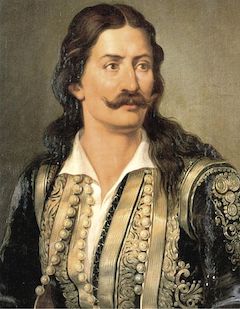Greek independence hero Athanasios Diakos died by Ottoman impalement on this date in 1821.*
 Though he acquired his nickname Diakos (“deacon”) from a youthful spell in a monastery, this fellow Athanasios (English Wikipedia entry | Greek) while the Turks still governed Greece made his way as a klepht — Greece’s version of the Balkan hybrid outlaw/guerrilla archetype, similar to the hajduk figures among the South Slavs. All of these outlaw types took to the mountains where they could subsist as brigands and mercenaries beyond the reach of the Porte, and seek opportunities where they might to strike at Ottomans. Many of the Greek persuasion, Diakos included, adhered to the Filiki Eteria secret society that aspired to liberate Greece.
Though he acquired his nickname Diakos (“deacon”) from a youthful spell in a monastery, this fellow Athanasios (English Wikipedia entry | Greek) while the Turks still governed Greece made his way as a klepht — Greece’s version of the Balkan hybrid outlaw/guerrilla archetype, similar to the hajduk figures among the South Slavs. All of these outlaw types took to the mountains where they could subsist as brigands and mercenaries beyond the reach of the Porte, and seek opportunities where they might to strike at Ottomans. Many of the Greek persuasion, Diakos included, adhered to the Filiki Eteria secret society that aspired to liberate Greece.
With the onset of the Greek War of Independence in early 1821, Diakos jumped right into the fight. Picturesquely, he met a much larger Turkish detachment in battle at Thermopylae where he made like Leonidas and with a handful of companions heroically held out against impossible odds at the Alamana Bridge.
Captured wounded, Diakos spurned the temptation of an officer’s commission in the Turkish army should he but switch sides with words that remain legendary in his homeland to this day: “I was born a Greek, I shall die a Greek.” He was impaled at the city of Lamia, fearlessly musing, “Look at the time Charon chose to take me, now that the branches are flowering, and the earth sends forth grass.”
He’s a very famous and beloved figure in Greece, albeit much less so in parts beyond. The village where Diakos was allegedly born has been renamed for him full stop.
* The narratives I’ve seen run a bit hinkie between the Battle of Alamana on April 22 and the great klepht’s death on April 24 since there’s a two-day gap and everyone seems to agree that he was ordered for execution “the next day”. I’m sticking to the agreed death date here, which is universal, but as best I can discern the timeline alternatives for accounting the missing day appear to break down between the notion that Diakos was impaled on the 23rd and lingered on his spike overnight before death, and that it was not until the 23rd that the Ottoman commander had the opportunity to interrogate him and decide his fate and thus “the next day” was the 24th. I haven’t located a source that appears dispositive on this issue.
On this day..
- 1935: Three Venizelist officers - 2020
- 1752: Nicholas Mooney, penitent thief - 2018
- 1852: Nathaniel Bowman, William Ide inspiration - 2017
- 1889: William Henry Bury, Jack the Ripper suspect - 2016
- 1751: Anna Schnidenwind, the last witch in Baden-Württemberg - 2015
- 1922: Colin Campbell Ross, for the Gun Alley Murder - 2014
- 1998: 22 for the Rwanda genocide - 2013
- 1945: A day in the death penalty around the Reich - 2012
- 1655: Massacre of Waldensians - 2011
- 1723: Major Jean Abram Davel - 2010
- 1521: The Comuneros of Castile - 2009
- 1868: John Millian, who martyred a madam - 2008


 Thus aggrieved, our man Rosli Dhobi (
Thus aggrieved, our man Rosli Dhobi ( The
The  The Austrian Sudeten German
The Austrian Sudeten German  The soldier
The soldier  “The White Woman of
“The White Woman of 
 A survivor of that horrific day — when he’d been dispatched from the orphanage that raised him to serve drinks to the protesters — Singh had unsurprisingly thrilled to the revolutionary cause.
A survivor of that horrific day — when he’d been dispatched from the orphanage that raised him to serve drinks to the protesters — Singh had unsurprisingly thrilled to the revolutionary cause.  An exemplar of that rare type persuadable to follow his moral commitments all the way out of the safety of a status quo sinecure,
An exemplar of that rare type persuadable to follow his moral commitments all the way out of the safety of a status quo sinecure,  A young St. Petersburg-trained tsarist officer with a patriotic bent — his father had taken part in the
A young St. Petersburg-trained tsarist officer with a patriotic bent — his father had taken part in the 
 The
The